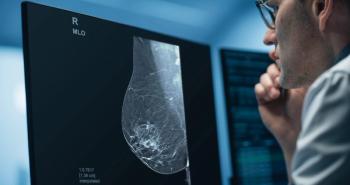
Federal study finds advanced technologies fall short
Modern imaging has a ways to go before it can replace breast biopsy. A study conducted by the Agency for Healthcare Research and Quality indicates that currently available noninvasive imaging methods fall short of the accuracy needed to determine conclusively whether a lesion is cancerous.
Modern imaging has a ways to go before it can replace breast biopsy. A study conducted by the Agency for Healthcare Research and Quality indicates that currently available noninvasive imaging methods fall short of the accuracy needed to determine conclusively whether a lesion is cancerous.
Researchers at the AHRQ, which is part of the U.S. Department of Health and Human Services, evaluated results from scintimammography, PET, ultrasound, and MR on 81 patients with suspicious breast lesions. They found that the four tests, if applied without biopsy, would miss between 4% and 9% of cancer cases among women at average risk for the disease. They concluded that more cancers might be missed in women at higher risk.
On the basis of their study, the researchers concluded that for every 1000 women who had a negative scintimammogram, 93 would have missed cancers. For the same number of women with negative scans, PET would miss 76 cancers, ultrasound 50, and MRI 38.
The numbers of women out of that 1000 who would avoid unnecessary biopsies would be 907, 924, 950, and 962, respectively, for each modality.
No one has yet established what rate of accuracy would be good enough to preclude the need for biopsy. The report cites a 2003 analysis by the Ontario Ministry of Health, however, which states that a negative predictive value of 98% or greater would provide an acceptable level for a diagnostic test to reliably preclude breast biopsy. A threshold of 98% means that 20 cases of breast cancer would be missed in exchange for avoiding 980 unnecessary biopsies. All of the tests in this evaluation fell short of that threshold.
"There is a wealth of information in this report that can give women and their healthcare providers detailed and helpful insight into the strengths and weaknesses of each of these techniques," said Dr. Carolyn M. Clancy, AHRQ director.
She and her colleagues wrote that the evidence supporting their conclusions permits them to be moderately confident that publication of future studies will not overturn their findings.
Not everyone agrees, however, with their conclusions. The American College of Radiology issued a statement calling the report simplistic, misleading, and inaccurate.
"It is well known among breast imagers (radiologists) that additional imaging studies should not be used to obviate the need for biopsy of a suspicious mammographic finding," said the ACR statement.
The ACR further stated that the AHRQ's Comparative Effectiveness Review, entitled "Effectiveness of noninvasive diagnostic tests for breast abnormalities," reflects a serious lack of understanding of the steps involved in detecting and diagnosing breast cancer with imaging procedures.
The college expressed concern that women would be misled by the report and might forego additional imaging after an inconclusive screening mammogram or might prematurely demand a biopsy. Most women with suspicious mammograms already undergo biopsy. Yet only about one in five of these women has breast cancer.
The need for confirmation of the mammogram means some 80% of women with an abnormal mammogram must undergo biopsy, even though they ultimately prove not to have cancer. Accurate noninvasive tests could reduce the number of women needing to undergo the procedure. More important, however, is finding cancer at the earliest possible stage. The five-year survival rate of stage 0 breast cancer is 100%. This drops to 16% for stage IV.
"Early and accurate diagnosis of breast cancer is crucial, and at this time, biopsies remain the most effective technique when mammography or physical examination reveals a potential problem," Clancy said.
Newsletter
Stay at the forefront of radiology with the Diagnostic Imaging newsletter, delivering the latest news, clinical insights, and imaging advancements for today’s radiologists.




























